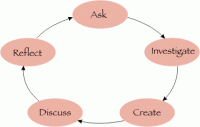
From the Cheche Konnen project
References
Beyer, B. K. (1971). Inquiry in the social studies classroom: A strategy for teaching. Columbus, OH: Charles E. Merrill.
Brown, John Seely, & Duguid, Paul (1993, March). Stolen knowledge. Educational Technology , pp. 10-15.
Falk, John H. (2005, July). Free-choice environmental learning: Framing the discussion. Environmental Education Research, 11(3), 265-280.
Lake, Kathy (1994, May). Integrated curriculum. School Improvement Research Series, Close-up #16. Portland, OR: Northwest Regional Educational Laboratory.
Rosebery, Ann S., Warren, Beth, & Conant, Faith R. (1992). Appropriating scientific discourse: Findings from language minority classrooms. The Journal of the Learning Sciences, 2(1), 61-94.
teachers.tv. Early years – from Reggio Emilia to the West Midlands. ![]() (resources site with 30-min video)
(resources site with 30-min video)
How can scaffolds for learning be provided?
References
Engestrom, Yrjo–activity theory, expansive learning, network learning ![]()
Kaptelinin, Victor, & Nardi, Bonnie A. Activity theory: Basic concepts and applications. In C. D. Lee and P. Smagorinsky (eds.), Vygotskian perspectives on literacy research: constructing meaning through collaborative inquiry. (pp. 51-85). New York: Cambridge University Press.
Vygotsky, Lev (1930). Mind in society. Cambridge, MA: Harvard University Press.
Wells, Gordon (2000). Dialogic inquiry in education: Building on the legacy of Vygotsky. In Carol D. Lee and Peter Smagorinsky (eds.), Vygotskian perspectives on literacy research: constructing meaning through collaborative inquiry. New York: Cambridge University Press.

